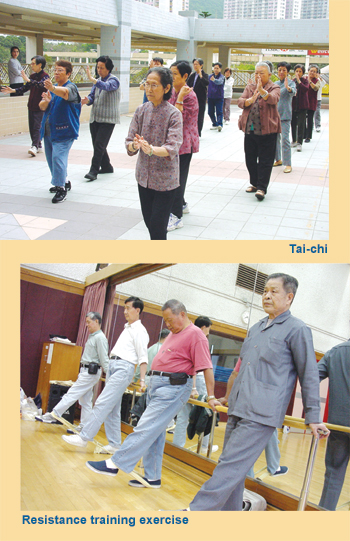 Tai-chi and Resistance Training Exercises - Would they really improve the health
of the elderly?
Tai-chi and Resistance Training Exercises - Would they really improve the health
of the elderly?
|

|
|
|
There is no doubt that exercise is good
for health, but what form of exercise is most suitable for the elderly? How do
we cater for individual needs when prescribing exercise programmes?
Tai-chi is very popular among the elderly in Hong Kong. Due to the lack of open space in Hong Kong, effective indoor exercise programmes which can be easily performed at home should be very useful for the elderly. A randomized controlled clinical trial was recently conducted by Prof. Edith Lau and her team, to test the health benefits of Tai-chi and other resistance training programmes, so that evidence-based recommendations can be made on the type of exercise suitable for elderly people with different health needs. ¡@ |
|
| Methodology | |
|
One hundred and eighty participants were randomized into three groups: the resistance training exercise group, the Tai-chi group, and the control group. In the resistance training exercise programme, subjects had to perform several activities against the force of a theraband: arm lifting, hip adduction and extension, heel raise, knee flexion, and ankle dorsiflexion. For the Tai-chi programme, subjects learned to practise a 24-motion Tai-chi exercise of the Yang style under the supervision of a Tai-chi master. The researchers then set out to investigate if the two different forms of exercise could enhance bone, muscle, heart, and mental health. Bone mineral density was measured by a dual X-ray densitometry, muscle strength was measured by a quadriceps device, and balance by a balance master. Subjects also underwent 24-hour electro-cardiographic monitoring. Measurements were taken at the start of the programme, and six months and 12 months afterwards.
¡@ |
|
| Results | Top |
|
Resistance training and Tai-chi were found to have different health benefits. The resistance training exercise led to increased bone mineral density at both the hip and spine --- the two most vulnerable sites for osteoporotic fractures. It also helped to strengthen the muscles of the lower limb and improve balance very substantially. Resistance training is therefore most useful for the prevention of falls and fractures among the elderly. Tai-chi, on the other hand, did not produce the same kind of effects on the musculoskeletal system. However, it was found to be very useful in lowering both the heart rate and blood pressure. This could be attributed to the emphases on meditation and concentration, and could contribute substantially to the cardiovascular health of the elderly. Interestingly, subjects in both exercise groups reported that their 'quality of life' was much improved by participating in these exercise programmes. The researchers conclude that elderly subjects with
different health needs may benefit from different forms of exercise. The most
ideal exercise programme should embrace the essential elements of both Tai-chi
and resistance training. Based on the findings of this research, such a
programme is currently being designed, and is expected to have significant
implications for the elderly in Hong Kong --- physically, mentally, and
socially. |
|
|
| |